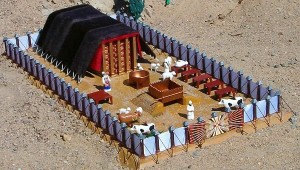The Bible Is the Story of Reconciliation Between Two Lovers —The Tabernacle Contains the Outline of that Love Story
Love and romance has captured the imagination of man since time immemorial. Today we see this fascination evidenced in music, movies, literature and numerous other ways including modern man’s obsession with sexuality and even, sadly, in rise of pornography and the societal acceptance of sexually perverse lifestyles.
The Creator of the universe, the Set Apart One of Israel, the Author of the Scriptures, is captivated by the concept of love and romance as well. He is the Creator of marriage and sex. In fact, his first command to man was to be fruitful and to multiply and to fill the earth with humans (Gen 1:28). To accomplish this involves sexual relations in marriage. The writer of Hebrews declares that marriage is honorable and the marriage bed is not to be defiled (Heb 13:4). Much of the Bible is devoted to the subject of love and marriage. Love and marriage at a human level is merely a shadow of something much deeper: love and marriage at a spiritual level. John 3:16, the most popular verse in the Bible, talks about Elohim’s quintessential love for mankind and alludes to this higher spiritual level.
Most people understand that poetry and poetic prose is the language of love, yet few realize that much of the Scripture is poetry (or poetic prose) in Hebraic style. Much of this poetic style is lost in the translation from Hebrew into other languages like English. For example, all the books of Psalms, Proverbs, Job, Song of Solomon, Ecclesiastes and most of the writings of the Hebrew prophets are written in a poetic style. Moreover, a Hebrew poetic style known as aggadic literature is also found in the Testimony of Yeshua (New Testament) in the parables of Yeshua.
Perhaps the greatest love song ever written by man is found in the Scriptures in the Song of Solomon. This poem is a tender and romantic story about the great love between a man and his bride. Many believe this is an allegory about YHVH-Yeshua and his bride, Israel, the body of believers called the saints. In Ephesians 5:21–33, Paul carries this marriage theme to the next level where he writes about the marriage relationship between a husband and wife and how that is a picture of Yeshua and the body of believers (the saints). He then goes on to say in verse 32 that, “This is a great mystery: but I speak concerning Messiah and the church.” The word mystery here in the Greek refers to “secret or hidden things relating to the deep and wise counsel of YHVH which is hidden to ordinary individuals and revealed only to a select or special group of people, in this case, the saints.”
Taking the idea of Yeshua and his bride, the saints to its highest level, John in Revelation 19:9 talks prophetically about the marriage supper of the Lamb and says in verses 7 and 8 that this marriage has come and his wife, the saints who have the testimony of Yeshua and keep his commandments has made herself ready by putting on the clean and white wedding garments which is the righteousness of the saints. These saints will rule and reign with Yeshua the Messiah forever and ever in his kingdom after his return to this earth.
In the Gospels on several occasions, Yeshua alludes to his upcoming marriage to his spiritual bride in typical poetic Hebraic fashion known as aggadic literature. We see this, for example, in the Parable of the Ten Virgins (Matt 25:1–13) and the Parable of the Wedding Banquet (Matt 22:1–14), not to mention the prophetic and allegorical implications found in his first recorded miracle — the changing of the water into wine at the marriage feast in Cana of Galilee. This upcoming marriage forms an essential aspect of the good news or gospel of the kingdom message that Yeshua preached. He came to prepare his bride for this wedding by urging her to “repent [of sin] for the kingdom of Elohim is at hand.” His kingdom on this earth will be fully and universally established when, at his second coming, he marries his bride, the spiritual body of believers (called the “one new man” in Eph 2:11–16), who he has redeemed with his blood, and who keep his commandments (Rev 12:17 and 14:12). At this marriage to redeemed Israel, there will be an exchange of vows (in Heb. ketubah), which Scripture refers to as the Renewed (or New) Covenant, which will be a fulfillment of Jeremiah’s prophecy (Jer 31:31 cp. Heb 8:8–13). This will cement a spiritual love relationship between YHVH and his people that will last for eternity as they together dwell in the New Jerusalem, which will be heaven on earth!
The Bible, from Genesis chapter one to the final chapter in the Book of Revelation is a love story that starts in a garden paradise with the Creator and a man and woman and ends in a city-garden and involves an eternal marital relationship between YHVH and his people. The Tabernacle of Moses outlines this story from beginning to end.
The Tabernacle, the Saint, and the Seven Stages of the Biblical Wedding
What follows is our attempt to integrate the seven stages of the biblical wedding with the seven stations in the Tabernacle of Moses in an attempt to show how YHVH’s plan of salvation as revealed in the tabernacle also relates to his plan to marry redeemed Israel (the saints) at his second coming. This is but one possible way to understand this complex subject. As we shall see, the numbers seven and eight figure prominently into this scenario. Seven is the biblical number for perfect completion, while eight is the number for new beginnings or infinity.
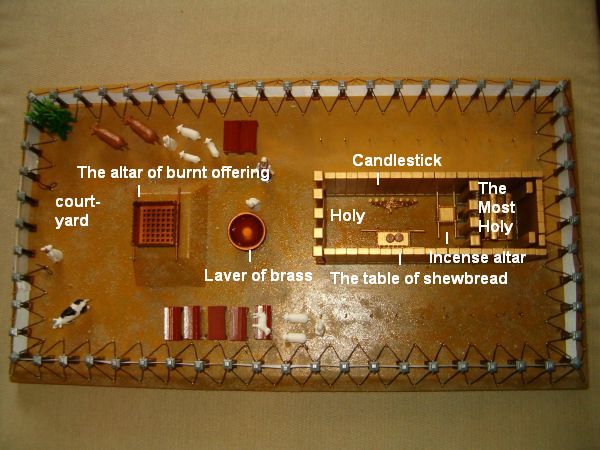
- 0 Intent — in the wilderness: The groom and bride see each other for the first time; interest is sparked, and they begin to “fall” in love. YHVH fell in love with Israe lwhen he saw her lost and abandoned in the wilderness of her existence (Ezek 16:4–14). This process begins in the wilderness outside the courtyard walls of the tabernacle (a metaphorical picture of spiritual salvation, redemption and conversion). Similarly, the believer, while still spiritually lost, prior to his conversion, hears the gospel message being preached (Rom 10:14–18) and is dr
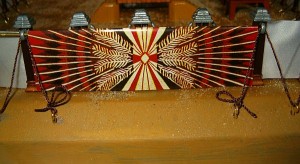 awn to Yeshua the Savior and Redeemer. Yeshua is the doorway to salvation leading to an eternal spiritual relationship between YHVH and man. This is represented by the four-colored door of the mishkan (picturing the four Gospels).
awn to Yeshua the Savior and Redeemer. Yeshua is the doorway to salvation leading to an eternal spiritual relationship between YHVH and man. This is represented by the four-colored door of the mishkan (picturing the four Gospels). - 1 Redemption — the altar of the red heifer: The bride’s price (dowry) is paid to the maid’s father. Before the young maiden’s father, the young man commits to lay down his life for his prospective bride. This Yeshua did for his spiritual bride when he laid his life down at the cross. The purification ritual involving the death of the red heifer outside of the tabernacle pictures this, and speaks prophetically of Yeshua’s death outside the city of Jerusalem at Golgotha, which occurred on Passover.
- 2 Acceptance — the altar of the sacrifice: The young man then presents the maiden with a glass of wine from which he first drinks. If she drinks, she is accepting his proposal of marriage. This is called the cup of acceptance and corresponds to the third cup of the Passover seder (cup of redemption). After s
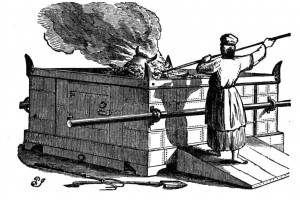 he drinks from the cup, the betrothal is legally established. Believers drink of this cup and eat the unleavened bread on the evening portion of Passover (Pesach )on thefifteenth day of the first month, hich is on the first high Sabbath and first dayof the Feast of Unleavened Bread. The altar of sacrifice inside the tabernacle is a picture f this as is the Christian communion ritual.
he drinks from the cup, the betrothal is legally established. Believers drink of this cup and eat the unleavened bread on the evening portion of Passover (Pesach )on thefifteenth day of the first month, hich is on the first high Sabbath and first dayof the Feast of Unleavened Bread. The altar of sacrifice inside the tabernacle is a picture f this as is the Christian communion ritual. - 3 Set-Apartness — the bronze laver: After the young man’s proposal is accepted and the betrothal is established, he returns to his father’s house to build a house for his betrothed bride. Meanwhile, the bride remains in her father’s home and prepares for her wedding day. She takes a ritual cleansin
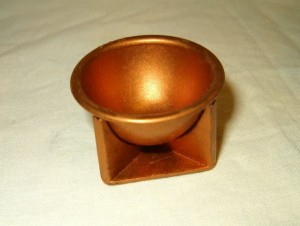 g bath (immersion or mikveh) to signify that she is ritually clean and totally set apart for her groom to the exclusion of all other would be suitors. She has accepted the groom and the terms of the marriage agreement (or ketubah) and now she awaits the return of her bridegroom and her wedding day. For the ancient Israelite, this occurred when they accepted YHVH marriage proposal and covenant terms at Mount Sinai. This is pictured by the bronze laver in the tabernacle where the priests were ritually cleansed, and is a prophetic picture of baptism for the remission of sins in the new believer’s life (Rom 6:3–6). Water is a metaphorical Hebraism for of the Word of Elohim (Eph 5:26), which is the believer’s marriage agreement or ketubah, which they promise to obey. The last high Sabbath or seventh day of the Feast of Unleavened Bread (Hag HaMatzot) pictures this, for it was then that Israel was immersed in the Red Sea (1 Cor 10:2, a picture of baptism and spiritual cleansing) after having removed leavening (a picture of repentance from sin) from their homes.
g bath (immersion or mikveh) to signify that she is ritually clean and totally set apart for her groom to the exclusion of all other would be suitors. She has accepted the groom and the terms of the marriage agreement (or ketubah) and now she awaits the return of her bridegroom and her wedding day. For the ancient Israelite, this occurred when they accepted YHVH marriage proposal and covenant terms at Mount Sinai. This is pictured by the bronze laver in the tabernacle where the priests were ritually cleansed, and is a prophetic picture of baptism for the remission of sins in the new believer’s life (Rom 6:3–6). Water is a metaphorical Hebraism for of the Word of Elohim (Eph 5:26), which is the believer’s marriage agreement or ketubah, which they promise to obey. The last high Sabbath or seventh day of the Feast of Unleavened Bread (Hag HaMatzot) pictures this, for it was then that Israel was immersed in the Red Sea (1 Cor 10:2, a picture of baptism and spiritual cleansing) after having removed leavening (a picture of repentance from sin) from their homes. - 4 Separation and Consecration — the menorah: After cleansing herself, the betrothed bride prepares for the return of the groom from his father’s house. While the groom is away building their marital home (or “mansion”), the bride lives a set-apart or consecrated life by keeping herself away from any other lovers. When the children of Israel accepted YHVH’s marital covenant terms at Mount Sinai, she vowed to be faithful only to him and to reject all idolatrous ways, and
to walk in faithful obedience to the light of his Torah. In the tabernacle, the menorah is a picture of the spiritual light of YHVH’s Torah-truth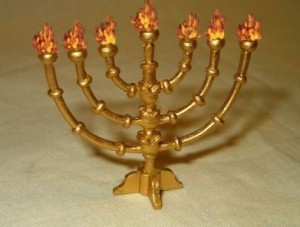 nd the Spirit of Elohim, which leads us into all truth. When a believer has the Torah written on his heart by the Holy Spirit and walks in the light of the YHVH’s Torah-truth, he will evidence the fruits and gifts of the Holy Spirit. The menorah relates to the Feast of Weeks (Shavuot)or Pentecost when, in Acts 2, the believers were filled with the Holy Spirit and had YHVH’s law of love written on their hearts. This resulted in the fruits and gifts of the Spirit being manifested as a light to the nations attracting those on the outside to the message of the gospel.
nd the Spirit of Elohim, which leads us into all truth. When a believer has the Torah written on his heart by the Holy Spirit and walks in the light of the YHVH’s Torah-truth, he will evidence the fruits and gifts of the Holy Spirit. The menorah relates to the Feast of Weeks (Shavuot)or Pentecost when, in Acts 2, the believers were filled with the Holy Spirit and had YHVH’s law of love written on their hearts. This resulted in the fruits and gifts of the Spirit being manifested as a light to the nations attracting those on the outside to the message of the gospel. - 5 Preparation, Regathering and Reunion — the table of showbread: The groom continues to prepare a “mansion” for his bride. Meanwhile, the bride dons her wedding robes, fills her lamp with oil, stays awake through the night awaiting her bridegroom’s return. At this time the groom leaves his father’s house and goes out to meet his bride. This is pictured in the tabernacle by the table of showbread (or the table of the presence or face of YHVH) upon which are twelve loaves of unleavened bread picturing the twelve tribes of Israel in a sin-free (righteous) and united
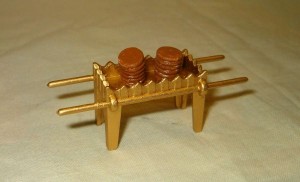 state, who are presenting themselves before YHVH. In the annual feast day (moedim) cycle, this is pictured by the Day of the Shofar Blast (Yom Teruah). Yeshua’s Parable of the Ten Virgins is a poetic picture of this. Some of the virgins prepared for the bridegroom, while other didn’t. All fell asleep while waiting. Now the call is going forth for all redeemed Israelite believers to awake out of spiritual slumber, to regather and to prepare to meet Yeshua the Messiah, her Groom whose coming is imminent. Yom Teruah is a picture of this momentous and long-awaited occurrence called the resurrection of the righteous dead who, at that moment, will receive their glorified bodies and will meet Yeshua in the air at his second coming.
state, who are presenting themselves before YHVH. In the annual feast day (moedim) cycle, this is pictured by the Day of the Shofar Blast (Yom Teruah). Yeshua’s Parable of the Ten Virgins is a poetic picture of this. Some of the virgins prepared for the bridegroom, while other didn’t. All fell asleep while waiting. Now the call is going forth for all redeemed Israelite believers to awake out of spiritual slumber, to regather and to prepare to meet Yeshua the Messiah, her Groom whose coming is imminent. Yom Teruah is a picture of this momentous and long-awaited occurrence called the resurrection of the righteous dead who, at that moment, will receive their glorified bodies and will meet Yeshua in the air at his second coming. - 6 The Return of the Wedding Party to the Bridegroom’s House — the altar of incense: At this time the wedding party makes final preparations to return to the father’s house where the marriage feast will occur and married life will start. Also at this time Yeshua, the Groom, will judge and destroy all counterfeit or would-be persecutors of and contenders for his bride along with all would-be or false b
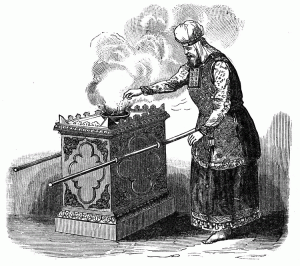 rides and counterfeit religious systems. Some of the trumpets and the bowl judgments in the Book of Revelation seem to relate to this time period. To mark this momentous event, the final or great jubilee shofar will sound marking the fall of Babylon the Great and the release of its spiritual captives. The altar of incense and the Day of Atonement (Yom Kippur) prophetically picture this event marking the end of what is called in Jewish thought “the final redemption.”
rides and counterfeit religious systems. Some of the trumpets and the bowl judgments in the Book of Revelation seem to relate to this time period. To mark this momentous event, the final or great jubilee shofar will sound marking the fall of Babylon the Great and the release of its spiritual captives. The altar of incense and the Day of Atonement (Yom Kippur) prophetically picture this event marking the end of what is called in Jewish thought “the final redemption.” - 7 The Consummation of the Marriage and the Wedding Feast — the ark of the covenant: The young couple now returns to the father’s house to the marriage “mansion” the young groom has constructed for his new bride. It is there that the marriage is consummated, the couple begin living together and the weddi
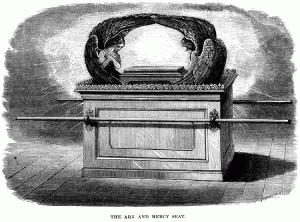 ng feast occurs. The holy of holies (kadosh hakadoshim) at the ark of the covenant is a prophetic picture of this, and points us to the Feast of Tabernacles (Sukkot), which is a 1000-year long celebration referred to as the Millennium or Messianic Age. During this time, Yeshua the Bridegroom will rule over this earth as King of kings along with his wife, the glorified bride of Yeshua.
ng feast occurs. The holy of holies (kadosh hakadoshim) at the ark of the covenant is a prophetic picture of this, and points us to the Feast of Tabernacles (Sukkot), which is a 1000-year long celebration referred to as the Millennium or Messianic Age. During this time, Yeshua the Bridegroom will rule over this earth as King of kings along with his wife, the glorified bride of Yeshua. - 8 Life Happily Ever After — the glory cloud over the ark: The young couple starts married life together. Yeshua and his bride will live together in their new home — the paradise garden city of the New Jerusalem forever (Olam Haba). The Eighth Day (Shemeni Atzeret), which is the seventh of YHVH’s seven annual appointed times (moedim), pictures this. The glory cloud (shekinah) above the ark of the covenant in the tabernacles is a picture of the glory of the New Jerusalem whe
 n heaven and earth unite and YHVH lives with his redeemed and glorified people (or bride) forever.
n heaven and earth unite and YHVH lives with his redeemed and glorified people (or bride) forever.

